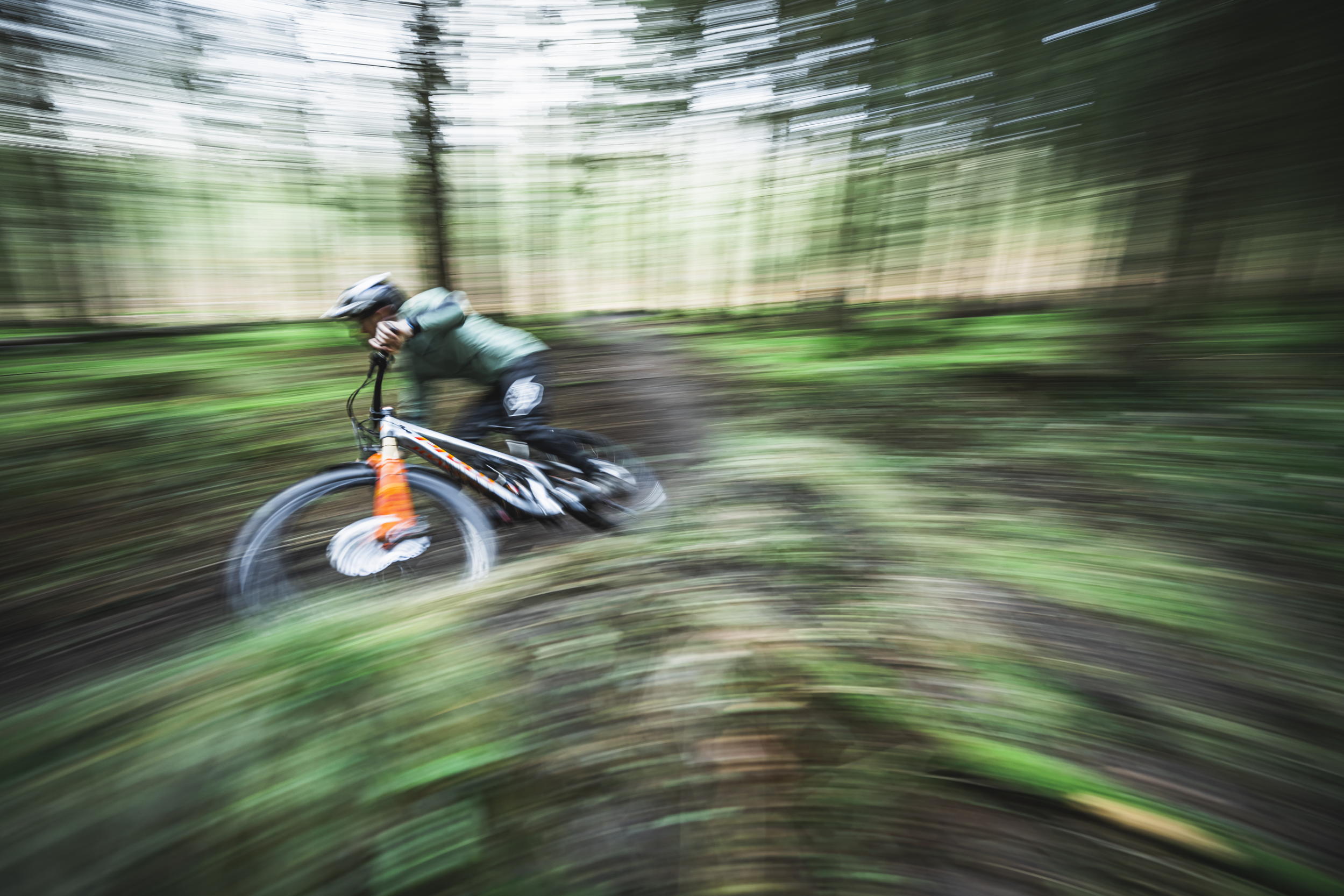Got goals for 2024? Racing? Riding further and faster? Tackling a mountain or two? Then strap on that heart rate monitor because here’s how to train for it all
Riding faster, going further and generally having a better and more enjoyable experience on a bike is probably on every mountain biker’s hit list. And to do it, all* you have to do is to gain a little bit of fitness to boost your performance.
OK so I asterisked that ‘all’ because getting stronger and fitter for mountain biking does take a certain amount of effort. It doesn’t have to be a dreadful, painful experience though: The rewards are well worth it, while the process of self improvement can be really rewarding.
So here’s our guide to training your body to ride faster, further and harder in 2024.

Riding slower is more effective for building stamina and strength, metre your efforts with the talk test
1. Go slow to ride fast
Don’t make every ride a smash fest, instead most of your training should be done at a slow pace, in what’s commonly known as Zone 2. Without getting too sciency about it, this is because it increases the blood flow around the body and it’s good for the mitochondria, which power your cells.
Around 80% of your training needs to be done in this slow state then. We’ve put together an article to explain exactly how to calculate your workout zones, but the good news is you don’t actually have to. That’s because you can use perceived effort instead, for Zone 2 just make sure you can still hold a conversation while you’re working out. If you’re gasping for air you’re going too hard. This steady state training works too because your body can recover easily from it, without leaving you wasted and demoralised.
“The benefits of going on longer, slower rides are well understood,” explains elite coach Jonny Thompson. “These include improved fat burning for fuel, so you’re less likely to bonk or need a snack every 45 minutes, which in turn reduces oxidative stress and leads to improved endurance and health.”

Off the bike training us vital if you want to progress your riding
2. Work out off the bike
That’s all very well, but how the heck do you do this on your traditional mountain bike ride, where heart rate goes through the roof? The answer is going to be different for everyone, but in my opinion you can’t. At least, not on a proper ride with your friends.
Instead you’ll need to make time for something else, which really sucks but the gains will be worth it in the long run. Turbo training a la Greg Callaghan is easy and consistent, while running is a good use of time and works well for some riders who can’t stand the idea of working out inside (me, in other words).
The Athertons’ coach Alan Milway says: “Running is incredibly time efficient, and a short 20-30 minute run is easier to work into a morning routine than most other activities. Short, manageable sessions can be overlooked but can add together over the course of weeks or months to make a huge difference in overall fitness and weight loss too.”
If you’re lucky enough to have an e-bike you could try proper mountain biking for fitness, but be careful not to work too hard on the descents, where you’re distracted from your efforts. You could also build it into a commute.

Time to increase the speed – high-intensity training provides the gain as well as the pain
3. Then go really hard
“When it’s time, you go hard. You go really hard,” Jonny Thompson told us.
If 80% of your riding is done at a slow pace that leaves 20% of your time for working at a near-maximum output. “Most of us ride at the same pace all the time, so we never force our bodies to adapt,” Jonny says. But this is the part where you need to bury yourself.
High intensity training is important for increasing your power on the bike, and how long you can sustain that power for. It’ll improve your VO2 Max, which is how much oxygen your body can use, and that really is the key to riding faster for longer. Read on for how to do that.

Feel the burn with an interval session.
4. Use interval training
The slow part is pretty easy to do then, but going hard is a nasty business, meaning you want to get it done as efficiently as possible. That’s where interval training on your mountain bike comes in.
Interval training is an exercise structure that mixes periods of exercise at a set (generally quite high) intensity, with periods of recovery between them, thus allowing you to repeat these efforts multiple times.
It’s perfect for mountain bikers, Jonny Thompson says: “We need good levels of fitness to simply complete hilly rides, we also need a burst of sustained acceleration on every ride to tackle changes in terrain and gradient.”
You can mix it up any way you like, varying the time you spend smashing it, the time you spend resting between exercises, and the number of repetitions you use. The best place to start is a Four x Four routing – four minutes of hard effort, four minutes of rest, repeating it four times. Yup, a nasty business indeed.
Why is this a good thing for riding faster? Simple, the rest periods mean we can increase our total time at the elevated efforts; thus allowing the body to adapt to them and increase the amount of time we can spend at higher intensities.
It also raises the threshold at which fatigue occurs meaning that if we perform subsequent exercise that is under this threshold, we won’t fatigue as readily. Challenging the body to deal with increased lactate levels, and adapt to these is a key part in this process.

Wearables are key to tracking your training
5. Get a heart rate monitor (or not, as you choose)
Heart rate monitors are ideal tools to monitor effort and gauge pacing, and there are a ton of them to choose from – the best we’ve found is Garmin’s Fenix 7. Alan Milway describes the HRM as “your go-to gadget, great for helping you get a good idea of what certain efforts ‘feel’ like. The better your understanding, the better you will be able to note progress.”
But guess what? You don’t have to if you’d rather not spend the cash. That’s because you can use your perceived effort again as a pretty good indicator – if you can still hold a conversation you’re probably doing some good easy training, and if you’re fighting for breath and can’t go another second more you’re clost to your max.
It’s not the only tool you can use though, if you’re out riding it’s easy enough to use one piece of trail and time your effort up it. This will set the pace for further efforts. Interval sessions are shorter than normal rides — don’t worry if you have only exercised for 45-55 minutes and the session is over. Quality over quantity is what you’re after. You should also vary the duration of effort and duration of rest for best benefit — but only after you have completed a few weeks of one session. Don’t jump from one to another.

Strava’s great for finding trails, building a riding group and having fun, but you can also use it to train smarter
6. Use a training app
The rise of the smartphone has produced an army of zombies, and when riding there’s no escaping the need to stop and show the world what we’re doing. However, tracking rides can be very useful. Using the data to give average length of ride, total duration over the course of a week or month, and also to set challenges to beat personal best times can be a very useful motivational tool.
There are a number of training apps now where you can follow a training calendar and training programme, and they offer plenty of tools to assess progress. However, be mindful that if you are out to have fun with your friends at the weekend, your ride should not be defined purely be whether you or not your got a Strava KOM. Target certain rides to beat previous goals and by logging rides in a training calendar you will be able to see how your riding is improving.
7. Create a ‘race track’ to practise
That’s the fitness bit dialled, just make sure you keep the ratio of easy to hard right (80:20) and the amount you do is totally up to you. But riding harder isn’t just about being fit, if you’re heading to a race it’s a good idea to try and recreate the race feel in the comfort of your own woods.
“A common mistake people make is to try to go five times quicker than their normal speed when they start racing,” former EWS winner Jerome Clementz told us. “You need to increase intensity and concentration, but don’t try to go too fast. Keeping the flow, trying not to make any mistakes and not rushing if errors do happen in stages will always make for faster overall times.”
The best way to practise this is to ‘build’ a race track of your very own. Choose a hill with a well rounded collection of features you think might appear on race day proper – a rocky section, something fast, a jump, something off-camber and a climb should do it.
Then it’s just a case of hitting up the loop so you can experience the feel of racing. Just make sure you warm up with a sighting lap. The whole idea is to make racing more relaxing when it comes to race day, putting you in your comfort zone, with everything but the fun bit already completed.

Corners are often the slowest part of any ride, so it makes sense to get better at them for racing or riding
8. Practice corners
There’s an old saying in mountain biking, ‘jumps are for show, corners are for dough.’ In short, jumps look great but getting round a corner faster improves your speed more. In fact it’s probably the single most important skill for racing. Here’s our full guide on how to get better at cornering a mountain bike.
Practise it then. Take some time each week to go through some corner drills. If you have some linked corners on a trail near you that’s great, but you can create your own pretty easily too. All you need is some forgiving round and half a dozen cones to corner round.
Concentrate on looking ahead and making sure you get a good exit to the last corner to carry speed down the trail.
Dirt School’s Andy Barlow says: “Take your time on the way in. If you spend time setting up in a good body position, scrubbing speed off while you have control, and setting up your line properly, then as the corner progresses you should feel like you’re accelerating the rest of the out. Going fast is about feeling confident. And feeling confident is about having control. Don’t try and go fast. Try and focus on having more more control. You’ll do this by giving yourself more time to react on the way in.”

Pistol squats are great for mountain bikers, building strength and stamina
9. Get stronger too
Improving your cardiovascular fitness is really important for mountain biking, but so too is making your body more powerful. It’ll help you ride faster, and protect you better from injuries too. We have stacks of ideas for gym and home training to get your body stronger, but there are three fundamental principles to go by.
The first is variation, the longer you keep doing the same thing the less improvement you’ll make. That means you need to do different things all the time, rather than just relying on, say, the deadlift to increase your leg power. Variation also helps reduce the risk of burn out and boredom.
That said, deadlifts are killer moves for mountain bikers, they “allow you to pedal harder for longer, hold a more solid riding position, and take bigger impacts buckling,” Jonny Thompson says.
Second, consider the function of the exercise you’re doing, if you can see it’s really important for mountain biking then get on it. That means squats are almost certainly in, while building a Third, intensity. Ticking the boxes and going through a workout might feel good, but without giving them due effort your improvements will be lacking. Where appropriate, the effort you put in directly correlates to what you get out, sometimes that means spending time being very uncomfortable. Intensity done right will not only transform your riding, but could change your life in other positive ways.
If you do just one thing…
All of us are pushed for time, and there are always other things competing for our time – work, family or actually riding for fun are pretty high up there. So if you’ve only got time for one thing to get fit this year, here is elite coach Becky Skelton’s super short workout, suitable for beginners or pros alike.




